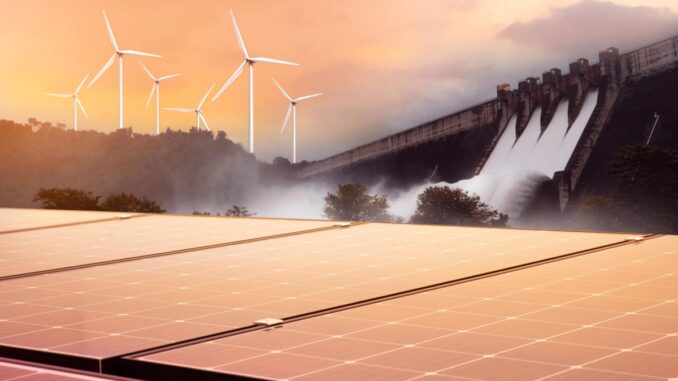
Electricity Generation: Wind turbines convert kinetic energy from the wind into electrical power. Wind farms can be located onshore or offshore, depending on wind availability and land use considerations.
Grid Integration: Modern grid technologies and storage solutions help integrate wind energy into the electricity grid, ensuring stable supply despite wind variability.









Solar Energy
Photovoltaic (PV) Systems: Solar panels directly convert sunlight into electricity and can be installed on rooftops, in solar farms, or as part of building materials.
Concentrated Solar Power (CSP): Uses mirrors or lenses to concentrate sunlight onto a small area to produce heat, which then generates electricity through steam turbines.
Hydroelectric Power
Dams and Reservoirs: Large-scale hydroelectric projects use dams to store water in reservoirs, releasing it to generate electricity as needed.
Run-of-River Systems: These systems generate power without significant storage, maintaining more natural river flow conditions and reducing environmental impact.
Biomass Energy
Biofuels: Organic materials are converted into biofuels like ethanol and biodiesel, which can be used in place of traditional gasoline and diesel.
Biogas: Produced from the anaerobic digestion of organic waste, biogas serves as a renewable substitute for natural gas.
Geothermal Energy
Electricity Generation: Utilizes heat from the Earth’s interior to generate electricity. Geothermal plants provide a stable, continuous source of power.
Direct Use Applications: Geothermal heat can be directly used for heating buildings, greenhouses, and in various industrial processes.
Ocean Energy
Wave and Tidal Power: Technologies harnessing the energy from ocean waves and tidal movements are emerging, though they are not yet as widely deployed as other renewables.
2. Benefits of Replacing Fossil Fuels with Renewable Energy
Environmental Benefits
Greenhouse Gas Reduction: Renewables generate power without emitting CO2, significantly reducing the carbon footprint.
Reduced Air and Water Pollution: Renewables do not produce pollutants like sulfur dioxide, nitrogen oxides, or particulates, leading to cleaner air and water.
Economic Benefits
Cost Competitiveness: The decreasing cost of renewable energy technologies makes them increasingly competitive with fossil fuels.
Job Creation: Renewable energy sectors generate employment in manufacturing, installation, operation, and maintenance.
Energy Security
Diverse Energy Mix: Renewables reduce dependence on imported fossil fuels, enhancing national energy security and resilience against global market fluctuations.
Localized Energy Production: Decentralized renewable energy systems provide local energy solutions and increase grid resilienc.
Social and Health Benefits
Public Health: Reduced air pollution from fossil fuel combustion results in better health outcomes, including lower incidences of respiratory and cardiovascular diseases.
Community Empowerment: Renewable energy projects can drive local economic development and provide access to energy in remote or underserved areas.
3. Challenges and Solutions
Intermittency
Challenge: Wind and solar power are intermittent, depending on weather conditions.
Solution: Energy storage systems, such as batteries, and grid modernization efforts help balance supply and demand.
Infrastructure and Investment
Challenge: Transitioning to renewable energy requires significant investment in new infrastructure and technology.
Solution: Policy incentives, government subsidies, and private sector investments are essential to fund this transition.
Land Use and Environmental Impact
Challenge: Some renewable energy projects require substantial land and can affect local ecosystems.
Solution: Strategic planning and adopting technologies with lower environmental impacts can mitigate these issues.
4. Global Examples and Trends
Germany: Known for its Energiewende (energy transition) policy, Germany aims to phase out nuclear power and significantly increase its use of renewables.
China: Leading in the installation of wind and solar capacity, China is rapidly expanding its renewable energy infrastructure.
United States: Various states are implementing aggressive renewable energy targets, with significant investments in wind, solar, and battery storage.
Conclusion
Replacing fossil fuels with renewable energy is a crucial step towards a sustainable and low-carbon future. The transition offers numerous benefits, including reduced greenhouse gas emissions, improved public health, enhanced energy security, and economic growth through job creation. Despite the challenges, continuous technological advancements, supportive policies, and strategic investments are driving the widespread adoption of renewable energy sources. This transition not only helps combat climate change but also promotes a cleaner, healthier, and more resilient energy system globally.

Leave a Reply